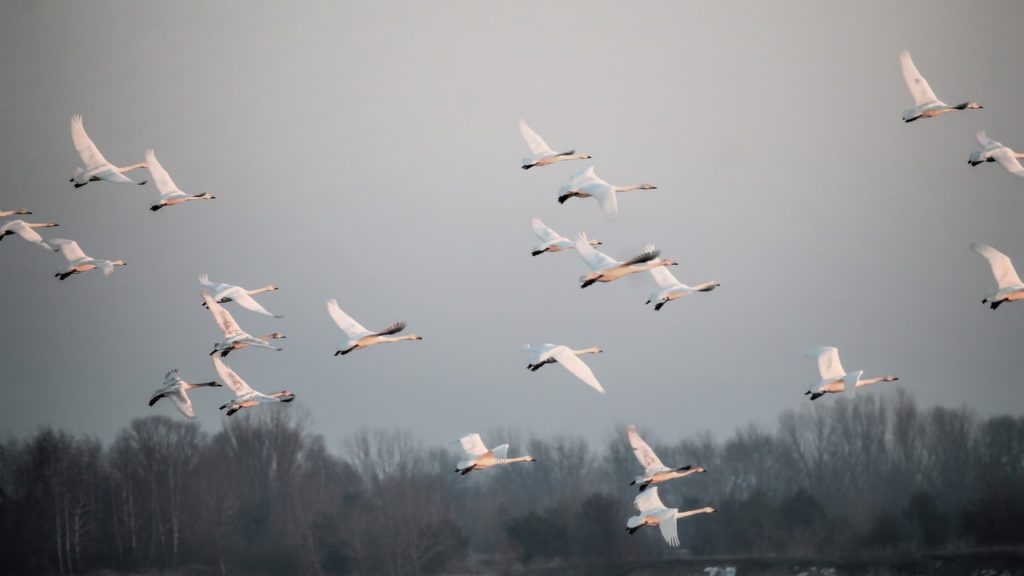
I learned this today. Birds migrate because of declining food sources and not because of the temperature drop over winter.
Birds migrate along a north south channel. They generally use a route that gives them the most opportunities for rest and food on the way. Their paths are usually dictated by natural landmarks like mountains or seas.
Some birds don’t migrate very far, but some travel a very long way. The Arctic tern travels farther than any other bird and has a 96,000 km roundtrip from the north pole to the south pole and back again.
I always thought that the reason they migrated was to escape the cold weather, but that is not the reason. Most birds can actually survive very well in cold weather. Birds have evolved several methods of surviving the winter. Firstly, their legs and feet are maintained at a very low temperature and their feet may even reach freezing point in winter. To survive this, they don’t have much fluid in the cells of their legs. Their legs and feet are mostly tendons and bones without much muscle or nerve tissue. They also don’t have many pain receptors in their feet. Their blood circulation is extremely fast, and their blood doesn’t spend long enough in their legs to freeze. Their vessels are so close together that blood about to leave the body for the legs gives up its heat to the blood returning from the legs, meaning that heat doesn’t leave their body. The second trick they have is their feathers. They can puff out their feathers creating trapped pockets of warm air. Their feathers provide an insulating layer. Another thing they do is huddle together. Penguins do this in bad weather. They take it in turns to be at the warm center of the huddle. The last thing they do is to have a very high body temperature, between 39 and 43℃, that they maintain by eating as much as they can.
And that is the main reason why birds migrate in the winter. Their food source disappears. Not all birds migrate. The birds that don’t migrate have a reliable food source that will survive the winter. Crows, for example. Woodland crows migrate in the winter, but city crows tend not to. When some of a species migrate and some don’t, it is called “partial migration”. The city crows probably migrate a short distance away to breed, but they don’t need to go far because they have food all through the winter. Most city crows have an ample source of trash to eat.
Obviously, different species of bird eat different things, but most birds eat insects, seeds, berries, fruit, and nuts. All of these things are seasonal. In the winter, most insects either migrate or overwinter in some state of hibernation. The overwintering ones usually find somewhere to hide and become unavailable as a food source for birds. The birds have no choice but to move to where there is more food. The ground also freezes, meaning they cannot pull up worms and grubs.
Bird migration is sparked by an internal biological clock that tells them when the seasons are changing. It takes its cues from changes in the length of the day and the air temperature. When their bodies tell them that migration time is coming, they start to eat as much as they can, fattening themselves up for the exertion of the journey.
Birds use the sun to navigate but they also have an ability to detect magnetic fields. It is possible that the birds can actually see the magnetic field. However, it also appears that birds learn the route, or are taught by older birds. GPS tagged birds have been studied and older birds that have flown the route before are better at making course corrections for wind drift.
There is a lot of risk to birds that migrate. The distances are long and there are many predators along the route. The risk of starvation is huge, and birds do get lost, despite their abilities. Storms and bad weather are a risk as well. However, these risks notwithstanding, it makes more sense for the birds to migrate than to try to find food where they were.
So, birds are perfectly capable of surviving through a cold winter because of the adaptations in the legs, their warm feathers, and their higher body temperatures. They migrate because their food sources disappear during the winter. Birds that have a reliable winter food source tend not to migrate. Birds react to the shortening day and the changing temperature by fattening themselves up to get ready to fly. They migrate along north south corridors and they can follow the magnetic fields in the Earth. And that is what I learned today.
Sources
https://en.wikipedia.org/wiki/Bird_migration
https://www.sciencedaily.com/releases/2018/08/180808093901.htm
